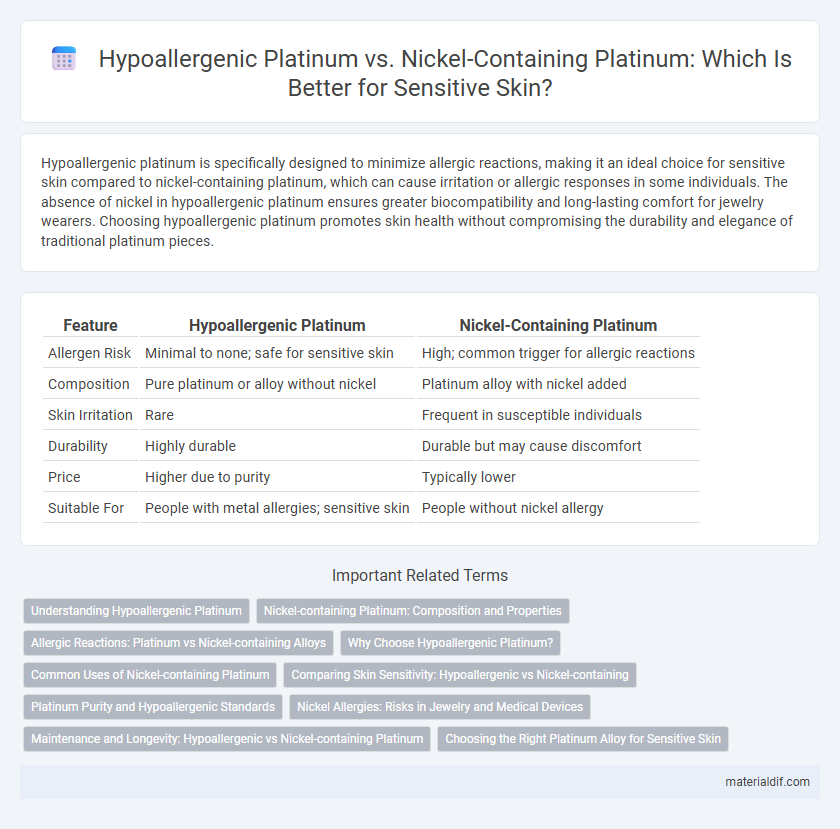Hypoallergenic platinum is specifically designed to minimize allergic reactions, making it an ideal choice for sensitive skin compared to nickel-containing platinum, which can cause irritation or allergic responses in some individuals. The absence of nickel in hypoallergenic platinum ensures greater biocompatibility and long-lasting comfort for jewelry wearers. Choosing hypoallergenic platinum promotes skin health without compromising the durability and elegance of traditional platinum pieces.
Table of Comparison
| Feature | Hypoallergenic Platinum | Nickel-Containing Platinum |
|---|---|---|
| Allergen Risk | Minimal to none; safe for sensitive skin | High; common trigger for allergic reactions |
| Composition | Pure platinum or alloy without nickel | Platinum alloy with nickel added |
| Skin Irritation | Rare | Frequent in susceptible individuals |
| Durability | Highly durable | Durable but may cause discomfort |
| Price | Higher due to purity | Typically lower |
| Suitable For | People with metal allergies; sensitive skin | People without nickel allergy |
Understanding Hypoallergenic Platinum
Hypoallergenic platinum is an ideal choice for sensitive skin due to its purity and lack of nickel, which is a common allergen in many metal alloys. Unlike nickel-containing platinum, hypoallergenic platinum minimizes the risk of skin irritation and allergic reactions, making it safer for individuals prone to metal allergies. This pure metal composition ensures durability and a hypoallergenic quality, providing long-lasting comfort and safety in jewelry.
Nickel-containing Platinum: Composition and Properties
Nickel-containing platinum alloys typically comprise approximately 5-10% nickel mixed with platinum to enhance hardness and durability, making them suitable for jewelry and industrial applications. The presence of nickel can improve resistance to corrosion and wear, but it may cause allergic reactions in sensitive individuals due to nickel's allergenic properties. These alloys maintain platinum's natural luster and high melting point, while balancing affordability and mechanical strength compared to pure platinum.
Allergic Reactions: Platinum vs Nickel-containing Alloys
Hypoallergenic platinum alloys are engineered to minimize allergic reactions by eliminating nickel, a common allergen found in many metal alloys. Nickel-containing platinum alloys often trigger skin irritations and allergic dermatitis in sensitive individuals due to nickel ion release. Platinum's inert properties significantly reduce the risk of allergic responses, making hypoallergenic platinum a safer choice for jewelry and medical implants.
Why Choose Hypoallergenic Platinum?
Hypoallergenic platinum is ideal for individuals with sensitive skin as it significantly reduces the risk of allergic reactions compared to nickel-containing platinum alloys, which often cause irritation and dermatitis. This pure form of platinum maintains its durability and brilliant luster without compromising comfort or safety. Choosing hypoallergenic platinum ensures long-lasting wearability and is especially recommended for jewelry, surgical instruments, and medical implants where skin contact is frequent and prolonged.
Common Uses of Nickel-containing Platinum
Nickel-containing platinum alloys are widely used in jewelry manufacturing due to their increased strength and durability compared to pure platinum, making them ideal for detailed designs and everyday wear. These alloys are also common in dental restorations and industrial applications where resistance to corrosion and high temperatures is essential. While hypoallergenic platinum is preferred for sensitive skin, nickel-containing platinum remains popular for its enhanced mechanical properties and cost-effectiveness.
Comparing Skin Sensitivity: Hypoallergenic vs Nickel-containing
Hypoallergenic platinum alloys minimize the risk of allergic reactions by excluding nickel, a common irritant known to cause skin sensitivity and contact dermatitis. Nickel-containing platinum, while durable and cost-effective, often triggers allergic responses in individuals with nickel sensitivity, leading to redness, itching, and discomfort. Choosing hypoallergenic platinum ensures safer wear for sensitive skin, reducing the likelihood of adverse dermatological effects.
Platinum Purity and Hypoallergenic Standards
Hypoallergenic platinum typically boasts a purity of 95% or higher, minimizing the risk of allergic reactions compared to nickel-containing platinum alloys which often include nickel at varying percentages, a common allergen. The high platinum purity ensures compliance with hypoallergenic standards set by dermatological and jewelry regulatory bodies, making it safer for sensitive skin. Nickel-containing platinum alloys, despite their durability, can cause contact dermatitis in individuals with nickel sensitivity, emphasizing the importance of platinum purity in hypoallergenic jewelry.
Nickel Allergies: Risks in Jewelry and Medical Devices
Hypoallergenic platinum is specifically designed to minimize the risk of allergic reactions, making it ideal for individuals sensitive to nickel, a common allergen found in some platinum alloys. Nickel-containing platinum alloys can trigger contact dermatitis and other allergic responses, posing significant risks in jewelry and medical devices that remain in prolonged contact with the skin. Choosing hypoallergenic platinum eliminates nickel exposure, reducing the incidence of allergic reactions and enhancing biocompatibility for both aesthetic and medical applications.
Maintenance and Longevity: Hypoallergenic vs Nickel-containing Platinum
Hypoallergenic platinum, free from nickel, offers superior maintenance benefits by reducing the risk of skin irritation and allergenic reactions, ensuring longer consistent wear without discomfort. Nickel-containing platinum may require more frequent cleaning and care due to potential allergic responses and increased susceptibility to tarnishing or discoloration. The inherent durability of hypoallergenic platinum combined with its biocompatibility supports enhanced longevity and sustained aesthetic appeal in fine jewelry.
Choosing the Right Platinum Alloy for Sensitive Skin
Hypoallergenic platinum alloys, typically 95% pure, minimize the risk of allergic reactions by avoiding nickel, a common irritant in metal jewelry. Nickel-containing platinum alloys, while more affordable, increase the likelihood of skin irritation and allergies for sensitive individuals. Choosing hypoallergenic platinum ensures durability and comfort for sensitive skin, making it the preferred option for long-term wear.
Hypoallergenic Platinum vs Nickel-containing Platinum Infographic

 materialdif.com
materialdif.com